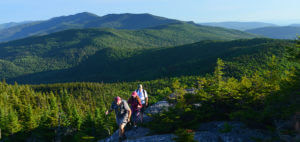Good news in the outdoors

There’s no shortage of distressing news these days. Let’s take a break from it all for a few paragraphs and savor some positive news.
Bats are back
While Shelburne Farms is essentially closed for the season, its resident bat population is robust. Over the decades, thousands of little brown bats have summered in historic buildings at the farm, building maternity colonies where they produce their young. In recent years a fungus, dubbed white nose syndrome, has decimated up to 90% of Vermont’s little brown bats. But the tiny mammals are thriving at Shelburne Farms.
Even as the farm’s thousands of resident bats consumed hundreds of millions of insects each year, their intersection with humans at the Inn at Shelburne Farms posed challenges. In an effort to keep guests and bats separated, the farm devised a multi-pronged plan. In 2001 they built a large bat house as they worked to exclude bats from the inn. Access points in and around chimneys and cracks in walls and soffits were sealed. Cooling fans installed in the attic made it less appealing to bats. With a current population of nearly 500, the bat house on the inn lawn houses one of the largest maternity colonies of endangered little brown bats in Vermont.
Snapper in the ’hood
She was a few days later than usual, but our neighborhood snapping turtle prowled the yard in mid-June, digging test holes in the driveway and perennial bed. She also scraped her carapace across newly planted grass. After two nights of exploration (and destruction) she settled for the edge of Mt. Philo Road. I’m delighted to say that mother snapper did not cross the road. This is the first time in years that she has laid her eggs on the same side of the busy thoroughfare as her home pond. Now the dozens of eggs, buried in loose soil, will incubate through the summer with temperature determining the sex of baby snappers. If the nest is not pillaged by raccoons, skunks or foxes—estimates are that 75 to 90 percent of snapping turtle eggs are consumed by predators—the babies will emerge at the end of summer and stroll to their pond.
Hope Cemetery
A recent article in the Sunday New York Times told of a monument to victims of the Spanish Flu Pandemic in Barre’s Hope Cemetery, one of few such remembrances in the world. In 2018 Brian Zecchinelli, the owner of the Wayside Restaurant on the Barre-Montpelier Road, and his wife Karen, commissioned a five-ton granite bench to commemorate the 50 million worldwide who perished in the pandemic. This coincided with the centennial of the Wayside, opened just a few months before the flu ravaged Barre in 1918.
An inscription on the monument reads: 1918 Spanish Flu Memorial. Barre, where granite workers with silicosis offered the flu a rich target, lost nearly 200 people, the largest loss of life in Vermont. Zecchinelli’s grandfather, a craftsman in the local granite factory, succumbed to the Spanish Flu at the age of 35. While researching his grandfather and the pandemic that killed him, Zecchinelli was fascinated by the flu’s near total disappearance from collective memory. There are few books, poems, paintings or plays and almost no memorials.
President Woodrow Wilson, although he nearly died from the flu in 1919, never mentioned the virus. Wilson focused exclusively on winning World War I, ramping up the armed forces while ignoring a disease that killed 675,000 Americans, more than all U.S. casualties of conflicts in the 20th century combined.
On a recent summer day I visited Hope Cemetery. After visiting the Spanish Flu Memorial, I wandered amidst the tombstones, admiring some of the better-known granite sculptures: a race car, giant soccer ball, and adjacent headboards with a couple reading in bed while holding hands. When I reached 30 deer etched into granite, I stopped counting. Fishing, sculpting, lawn mowing and camp are themes of remembrances that enriched the lives of the deceased. Hope Cemetery celebrates both lives lived and the artistry of Barre’s granite craftsmen. A visit makes a terrific staycation outing.
Silver Linings Dept.
The UVM Center on Research for Vermont interviewed a sampling of Burlington-area residents and found that 25.8% had rarely or never visited local natural areas before the pandemic. As a result of travel restrictions, 69% reported increased exploration of the natural world. A whopping 80% consider access to these areas of greater importance. Appreciation and love of nature and the outdoors generally leads to greater respect for and support of conservation and the environment.
Savor every bit of good news that comes your way; it’s good for your mental health. Get outdoors!

